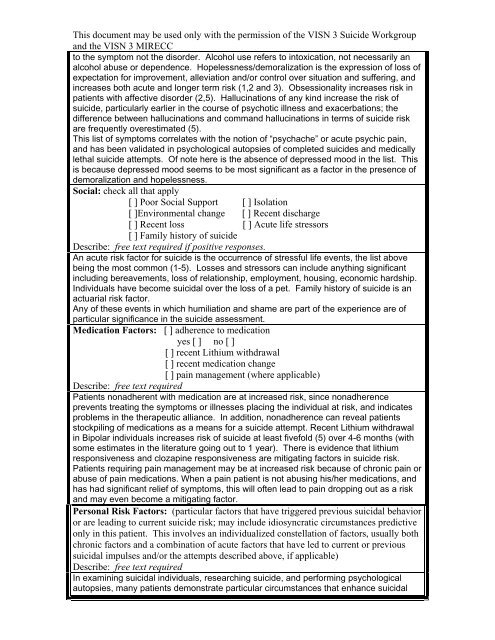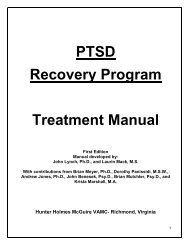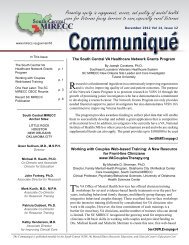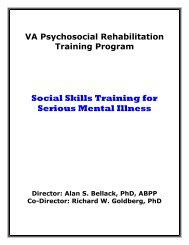Suicide Risk Assessment Package (VISN 3 MIRECC, US ...
Suicide Risk Assessment Package (VISN 3 MIRECC, US ...
Suicide Risk Assessment Package (VISN 3 MIRECC, US ...
You also want an ePaper? Increase the reach of your titles
YUMPU automatically turns print PDFs into web optimized ePapers that Google loves.
This document may be used only with the permission of the <strong>VISN</strong> 3 <strong>Suicide</strong> Workgroup<br />
and the <strong>VISN</strong> 3 <strong>MIRECC</strong><br />
to the symptom not the disorder. Alcohol use refers to intoxication, not necessarily an<br />
alcohol abuse or dependence. Hopelessness/demoralization is the expression of loss of<br />
expectation for improvement, alleviation and/or control over situation and suffering, and<br />
increases both acute and longer term risk (1,2 and 3). Obsessionality increases risk in<br />
patients with affective disorder (2,5). Hallucinations of any kind increase the risk of<br />
suicide, particularly earlier in the course of psychotic illness and exacerbations; the<br />
difference between hallucinations and command hallucinations in terms of suicide risk<br />
are frequently overestimated (5).<br />
This list of symptoms correlates with the notion of “psychache” or acute psychic pain,<br />
and has been validated in psychological autopsies of completed suicides and medically<br />
lethal suicide attempts. Of note here is the absence of depressed mood in the list. This<br />
is because depressed mood seems to be most significant as a factor in the presence of<br />
demoralization and hopelessness.<br />
Social: check all that apply<br />
[ ] Poor Social Support [ ] Isolation<br />
[ ]Environmental change [ ] Recent discharge<br />
[ ] Recent loss [ ] Acute life stressors<br />
[ ] Family history of suicide<br />
Describe: free text required if positive responses.<br />
An acute risk factor for suicide is the occurrence of stressful life events, the list above<br />
being the most common (1-5). Losses and stressors can include anything significant<br />
including bereavements, loss of relationship, employment, housing, economic hardship.<br />
Individuals have become suicidal over the loss of a pet. Family history of suicide is an<br />
actuarial risk factor.<br />
Any of these events in which humiliation and shame are part of the experience are of<br />
particular significance in the suicide assessment.<br />
Medication Factors: [ ] adherence to medication<br />
yes [ ] no [ ]<br />
[ ] recent Lithium withdrawal<br />
[ ] recent medication change<br />
[ ] pain management (where applicable)<br />
Describe: free text required<br />
Patients nonadherent with medication are at increased risk, since nonadherence<br />
prevents treating the symptoms or illnesses placing the individual at risk, and indicates<br />
problems in the therapeutic alliance. In addition, nonadherence can reveal patients<br />
stockpiling of medications as a means for a suicide attempt. Recent Lithium withdrawal<br />
in Bipolar individuals increases risk of suicide at least fivefold (5) over 4-6 months (with<br />
some estimates in the literature going out to 1 year). There is evidence that lithium<br />
responsiveness and clozapine responsiveness are mitigating factors in suicide risk.<br />
Patients requiring pain management may be at increased risk because of chronic pain or<br />
abuse of pain medications. When a pain patient is not abusing his/her medications, and<br />
has had significant relief of symptoms, this will often lead to pain dropping out as a risk<br />
and may even become a mitigating factor.<br />
Personal <strong>Risk</strong> Factors: (particular factors that have triggered previous suicidal behavior<br />
or are leading to current suicide risk; may include idiosyncratic circumstances predictive<br />
only in this patient. This involves an individualized constellation of factors, usually both<br />
chronic factors and a combination of acute factors that have led to current or previous<br />
suicidal impulses and/or the attempts described above, if applicable)<br />
Describe: free text required<br />
In examining suicidal individuals, researching suicide, and performing psychological<br />
autopsies, many patients demonstrate particular circumstances that enhance suicidal






